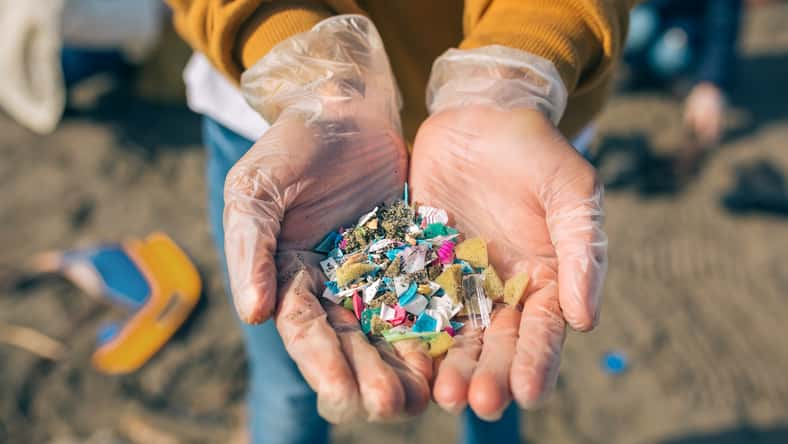Scientists Developed Synthetic Sponges Designed To Capture Microscopic Plastic Particles, Offering A Potential New Way To Tackle Microplastic Pollution

Sponges are like the Swiss Army knife of household items. For thousands of years, we have been using dried natural sponges for everything from cleaning and painting to even drinking liquids like honey and water.
Made from either natural or synthetic materials, sponges excel at trapping small debris in their multitude of pores. Not to mention, recent research suggests that these porous wonders might just have the potential to tackle one of today’s major environmental issues– microplastic pollution.
Back in August, a team of Chinese scientists released a study about their newly engineered synthetic sponge, designed to efficiently capture microscopic plastic particles.
Their experiments demonstrated that when a liquid containing carefully measured amounts of plastics is run through the sponge, it can effectively filter out not just microplastics but even tinier nanoplastics.
The performance of the sponge did vary, depending on factors like the amount of plastic in the liquid and its pH and salinity levels. However, under the right conditions, up to 90% of the microplastics were removed. The team also tested this in a range of liquids, from seawater and tapwater to even soup from a takeout restaurant.
These sponges are primarily composed of starch and gelatin. Resembling oversized marshmallows, they’re also so lightweight that you can place one on a flower without causing its petals to droop. This implies they would be cost-effective and simple to ship.
As for the sponges’ internal structure, their makeup doesn’t feature the typical bubble-like cavities you might expect. Instead, they have a more jagged surface structure.
Guoqing Wang, a materials chemist at Ocean University of China and one of the paper’s co-authors, detailed how the sponge’s composition is flexible. By adjusting the temperature during the mixing process of the two main compounds, the sponge’s porosity can be altered. In turn, this impacts the size of the particles the sponge can capture– with highly porous sponges being excellent for trapping extremely fine particles.
Should these spongers ever be manufactured on a large scale, Wang suggests they could serve practical purposes like filtering microplastics in wastewater treatment facilities or purifying water in food production plants.

David Pereiras – stock.adobe.com – illustrative purposes only, not the actual person
Christian Adlhart, a chemist at Zurich University of Applied Sciences in Switzerland who has also dabbled in developing sponge filters for microplastics, proposed another application: using these sponges in washing machines. Synthetic fabrics often release microplastics into water during washing cycles. Adlhart suggests that a sponge could be placed inside the washing machine drum to capture a significant portion of these released fibers.
These types of sponges operate through a couple of different mechanisms. When water is actively pushed through a sponge– say, by squeezing and releasing it– microplastic particles become ensnared in its pores, much like marbles collected in a bucket. Additionally, even when the sponge is just floating in stagnant water, some plastic particles will attach to it due to electrostatic forces.
Still, there are some bumps on the road to wide-scale adoption of these sponges. Adlhart pointed out how starch and gelatin, the main components, are also valuable to the food industry. So, there might be future competition for these raw materials.
That being said, alternative materials can be used to make similar sponges. For instance, the version that Adlhart and his team created uses chitosan, a sugar obtained from crustacean shells, as the structural base. Chitosan isn’t in high commercial demand, either, so it’s less likely to face the same supply challenges.
Adlhart explained that the inspiration for his sponge design, crafted from a web of chitosan nanofibers, came from oysters. These shellfish capture particles in their gills while circulating seawater through them.
While chitosan, starch, and gelatin are all biodegradable, there’s a hiccup in the eco-friendliness of the sponge developed by Wang and his team. They used formaldehyde, a highly toxic substance, in their manufacturing process, and traces of it remain in the finished sponges. Wang noted that they’re actively looking for an alternative method to create a fully green sponge.
Nonetheless, according to Alice Horton of the United Kingdom’s National Oceanography Center, what’s missing is evidence that these emerging sponge technologies are both cost-effective and capable of eliminating microplastics from water on a large scale. However, she’s fairly certain that attempts to remove microplastics once they’ve already entered the ocean are likely to be ineffective.
“I don’t think there is anything we can do on a large enough scale that will have any impact,” Horton said.
“We have to stop it getting there in the first place.”
To read the study’s complete findings, which have since been published in ScienceDirect, visit the link here.
If true crime defines your free time, this is for you: join Chip Chick’s True Crime Tribe
Sign up for Chip Chick’s newsletter and get stories like this delivered to your inbox.
More About:Science